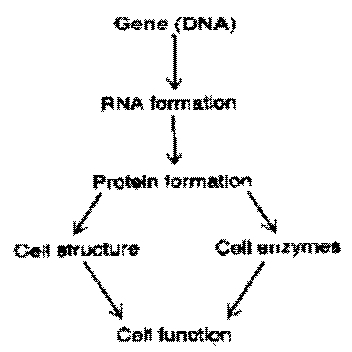 |
Fig. 54: General structure by which the genes control cell function. |
Virtually everyone knows that the genes control heridity from parents to children, but most persons do not realize that the same genes control the reproduction of and the day by day function of cells. The genes control cell function by determining what substances will be synthesized with in the cell—what structures, what enzymes what chemicals?
Fig. 54 illustrates the general scheme of genetic control. Each gene, which is a nucleic acid called deoxyribonucleic Acid (DNA), automatically controls the formation of another nucleic Acid, ribonucleic Acid (RNA) which spreads throughout the cell and controls he formation of a specific protein. Some proteins are structural proteins, which in association with various lipids and carbohydrates form the structure of various organelles. By for the majority of proteins are enzymes that catalise the different chemical reactions in the cell. For instance, enzimes promote all the oxydative reactions that supply energy to the cell, and they promote synthesis of various chemicals, such as lipids, glycogen, adenosine troposphere (ATP) and so on.
For the formation of each cellular protein there is usually only a single gene pair in each cell. It is estimated that cells of the human being have over 1,00,000 such gene pairs, which means that as many as 1,00,000 different proteins are formed in different cells, though not all of these in the same cell.[29]
 Prof. Dr. Sohan Raj Tater
Prof. Dr. Sohan Raj Tater
 Doctoral Thesis, JVBU
Doctoral Thesis, JVBU